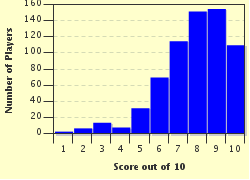Quiz Answer Key and Fun Facts
1. Which civilization is regarded as the first to have a functional theory of the planets?
2. The ancient Egyptians understood how to calculate the volume of a cylinder.
3. The first use of the concept of the "brain" was found in a medical text written in which language?
4. Many ancient civilizations worked with a calendar system. One of these civilizations, located in present-day Central America, worked with elements like the "Tzolkin" and the "Haab". Which civilization is this?
5. There was no meaningful study of the categorization of plants prior to 1753.
6. What artifact of Ancient India was a forerunner of modern stainless steel?
7. Ancient Roman civilization is particularly associated with a type of construction, many examples of which survive to this day, devised to transport water to the cities. What is the construction called?
8. The mixture of charcoal, potassium nitrate, and sulfur, which changed forever the science of warfare, was likely invented by which culture in the 9th century?
9. Robert Hooke was a true jack-of-all-trades scientist, with research into mathematics, chemistry, physics, and astronomy. His 1665 publication "Micrographia" explored his observations through a microscope. Which physiological term did Hooke coin in this work?
10. Invented in 1800, the Voltaic pile is one of the first examples of which world-changing invention?
Source: Author
shorthumbz
This quiz was reviewed by FunTrivia editor
CellarDoor before going online.
Any errors found in FunTrivia content are routinely corrected through our feedback system.

